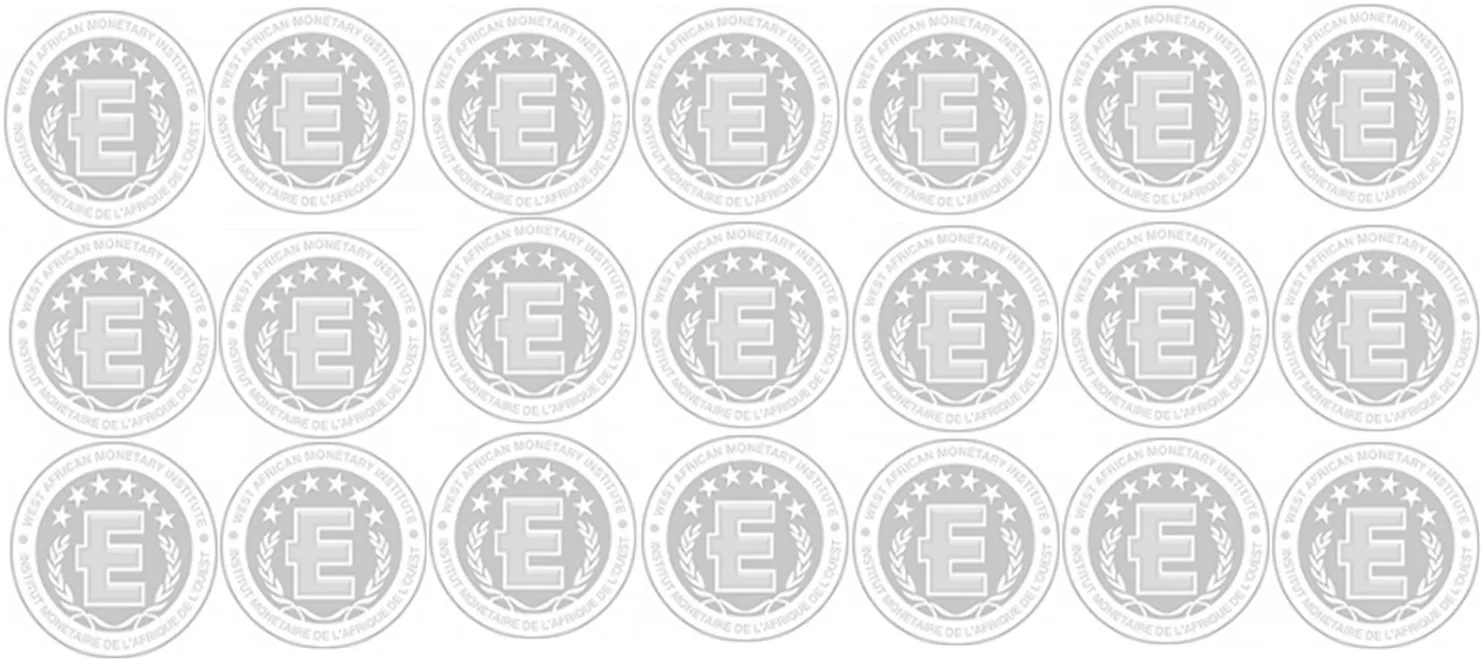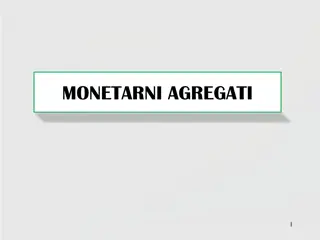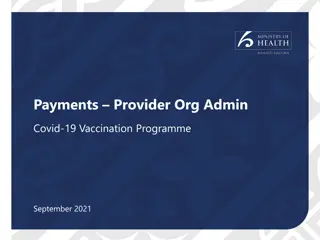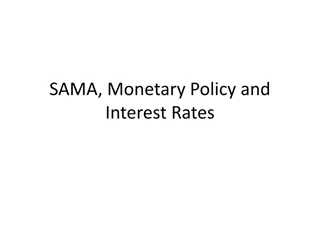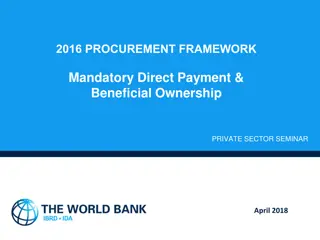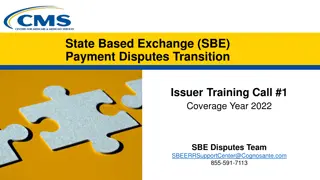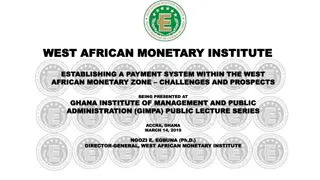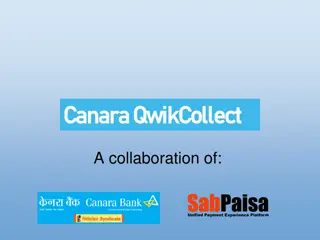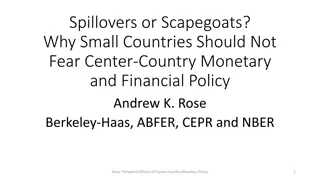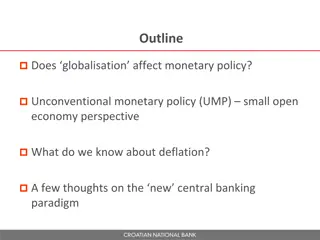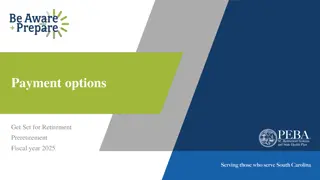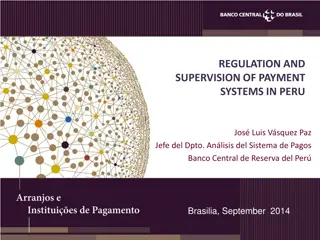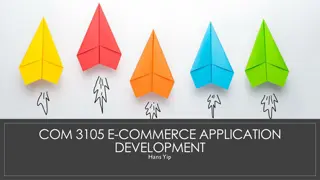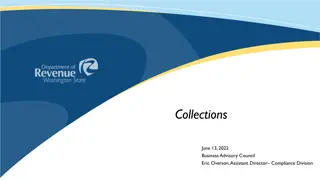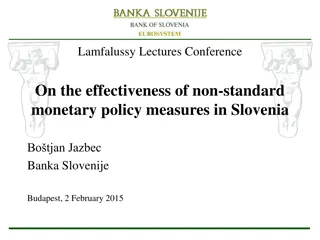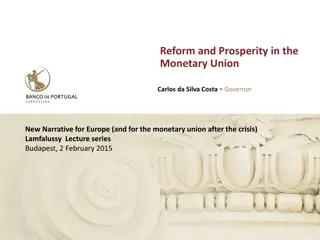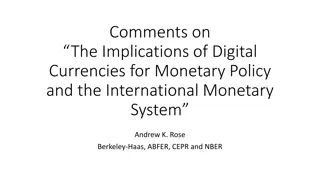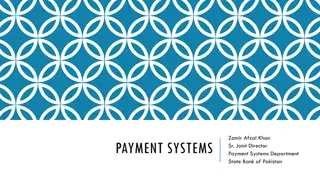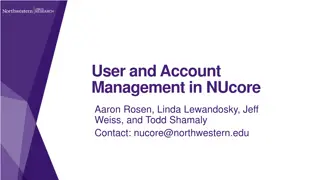Development of West African Monetary Institute Payment System
The West African Monetary Institute (WAMI) has been instrumental in establishing a payment and settlement system within the West African Monetary Zone (WAMZ). The institute's efforts have focused on promoting cross-border transactions and economic integration among member countries, with the ultimate goal of introducing a single currency. Through strategic pillars such as macroeconomic convergence, trade integration, and institutional capacity building, WAMI is driving the regional monetary integration process.
Download Presentation

Please find below an Image/Link to download the presentation.
The content on the website is provided AS IS for your information and personal use only. It may not be sold, licensed, or shared on other websites without obtaining consent from the author. Download presentation by click this link. If you encounter any issues during the download, it is possible that the publisher has removed the file from their server.
E N D
Presentation Transcript
WEST AFRICAN MONETARY INSTITUTE WEST AFRICAN MONETARY INSTITUTE PAYMENT PAYMENT SYSTEM SYSTEM EXPERIENCE IN EXPERIENCE IN THE WEST AFRICAN MONETARY MONETARY ZONE (WAMZ) ZONE (WAMZ) THE WEST AFRICAN BEING PRESENTED AT BEING PRESENTED AT ASSOCIATION OF AFRICAN CENTRAL BANKS (AACB) ASSOCIATION OF AFRICAN CENTRAL BANKS (AACB) WORKSHOP ON PAYMENTS SYSTEM WORKSHOP ON PAYMENTS SYSTEM CAIRO, EGYPT CAIRO, EGYPT APRIL 18 APRIL 18 - -20, BY BY NGOZI E. EGBUNA (Ph.D.) NGOZI E. EGBUNA (Ph.D.) GENERAL, WEST AFRICAN MONETARY INSTITUTE 20, 2019 2019 DIRECTOR DIRECTOR- -GENERAL, WEST AFRICAN MONETARY INSTITUTE
OUTLINE 1. Background 2. WAMZ Payments System Development 3. WAMZ Payment and Settlement System in The Gambia, Guinea, Liberia and Sierra Leone (Achievements) 4. Pan-African Payment and Settlement Platform 5. Unique Bank Identity (UBI) 6. Challenges 7. Prospects 8. Conclusion 2
Background The WAMZ was established in 2000 and it comprises: The Gambia, Ghana, Guinea, Liberia Nigeria and Sierra Leone The goal of the WAMZ was to implement activities development of a zonal payment and settlement system for cross border transactions, among other activities leading to the establishment of a common central introduction of a single currency including bank and 4
Background (Cont.) In 2005, the goal of the WAMZ was broaden to include economic integration; The Abuja Action Plan of 2009 approved a roadmap for the WAMZ Single Currency Project incorporating new structural benchmarks to facilitate WAMZ monetary integration process, culminating in to formulation of five strategic pillars to guide the WAMZ integration process 5
Background (Cont.) The strategic pillars are: Pillar I: Macroeconomic convergence, research and statistics Pillar II: Trade and regional integration Pillar III: Financial integration Pillar IV: Payment system infrastructure Pillar V: Institutional and capacity building 6
Background (Cont.) The Authority of Heads of State and Government of ECOWAS in 2014 adopted a Single-Track Approach to monetary union in West Africa and proposed the launch of a single currency by 2020 In view of this, the Institute is now responsible for managing and coordinating monetary integration activities within the WAMZ to enhance its effectiveness and serve as a platform for building consensus on and promoting economic integration, while ECOWAS Commission leads monetary integration process of the region 7
WAMZ PAYMENTS SYSTEM DEVELOPMENT 8
OBJECTIVES The main objective of the payments system development in the West African Monetary Zone (WAMZ) as part of the economic and monetary integration programme of zone has been the fulfillment of the following primary objectives: Eliminate, as far as possible, risks from payments, clearing and settlement systems. Speed up the exchange and settlement of funds and securities to levels that will effectively eliminate float. Improve convenience, service and security for users. The general trend is to migrate from cash and paper-based payment instruments to a state of high usage of electronic modes of payment. 9
OBJECTIVES Bring efficiency to government receipts and payments and leverage them for the financial deepening of the economies of the WAMZ member countries. Improve the WAMZ National Central Banks (NCBs) monetary management capabilities by reducing float and supplying timely accurate information on the flow of funds. Assess the legal framework that will support the modernization of payments system within the WAMZ member countries. Draw up criteria to integrate and attain harmonized interoperability to facilitate cross border payments. 10
WAMZ PAYMENTS SYSTEM DEVELOPMENT PROJECT IN THE GAMBIA, GUINEA, LIBERIA AND SIERRA LEONE- ACHIEVEMENTS 11
Introduction The Development Project in The Gambia, Guinea, Liberia and Sierra Leone funded by the African Development Bank (AfDB) was successfully completed in 2016. The primary objective of the Project is to develop and automate the payment system infrastructure of the four countries to the level already attained by Ghana and Nigeria. implementation of the WAMZ Payments System 12
Structure of the Project The components implemented under the Project in the four countries are: Real Time Gross Settlement (RTGS) system Scriptless Securities Settlement (SSS) System Automated Clearing House System Automated Cheque Processing System Core Banking Application (CBA) for the Central Banks Besides the payment system components, the Project included infrastructural upgrade in the form of Local Area Network (LAN) reconfiguration, Metropolitan Area Network (MAN) plus Internet and Information Technology (IT) Room Security and Energy. 13
Preference for electronic payments The zone had witnessed a gradual shift from the dominance of cash and cheques to the preference for electronic payments settlement in electronic products like ATM, POS, mobile money etc. Fig B: ATM Transaction 90,000 80,000 and 70,000 60,000 50,000 Volume 40,000 30,000 20,000 10,000 0 2015 2016 2017 2018 14
Cheque Clearing Time Reduced The volume of cheques cleared have declined over the years, suggesting increased usage of electronic payments system Gambia Gambia 200 179.5 180 171.2 155.8 160 Volume of Cheques cleared 000 140.3 140 120 100 80 60 40 20 0 2015 2016 2017 2018 15
Increased Digital Transactions The wave of digital transactions is gradually spreading across the zone as more innovative channels continue to be developed by FinTechs in response to the opportunity offered by the success so far recorded in the WAMZ Payments System Development Project. 16
Enhanced Financial Inclusion The upgrade of the payment system infrastructure facilitated the successful launch of mobile money services in The Gambia and Liberia thereby boosting financial inclusion 17
Increased Usage of Cheques In Guinea, the increase in the volume of cleared cheques was on account of confidence in the payment infrastructure as transactions are settled through cheques rather than cash. Fig D: Cleared Cheques 400,000 350,000 system 300,000 250,000 volume 200,000 150,000 100,000 50,000 0 2015 2016 2017 2018 18
Increased Usage of ATM and PoS Fig E: Volume of transaction In Liberia, the number of transactions using ATM and POS is on a consistent increase. The National Electronic Payment Switch (NEPS) promoted by the CBL has gone live respectively. 1,200,000 1,000,000 800,000 Volume 600,000 400,000 200,000 0 Cheques ATM 2014 POS 2013 19
Infrastructure Upgrade In Sierra Leone, the payment system infrastructure set the stage for the smooth implementation of electronic payment platforms such as ATM, POS and mobile money services. Volume of POS transactions Volume of ATM Transactions 1,000,000.00 35,000.00 900,000.00 30,000.00 800,000.00 700,000.00 25,000.00 600,000.00 20,000.00 500,000.00 400,000.00 15,000.00 300,000.00 10,000.00 200,000.00 5,000.00 100,000.00 0.00 0.00 2013 2014 2015 2016 2017 20 2013 2014 2015 2016 2017
Outcome The Project was successfully completed in 2016 and functioning efficiently in all the beneficiary Member States. The completion of the project paved the way for the ongoing interlinking of the Member States RTGS for cross-border transactions in local currencies through the Afreximbank s Pan African Payment and Settlement Plarform (PAPSP). 21
4.0 WAMI, in consultation with the Central Banks of the Member States of the WAMZ, and in partnership with Afreximbank, have taken giant strides to pilot the Afreximbank led Pan African Payments and Settlement Platform (PAPSP) in the WAMZ countries. The PAPSP is designed to create a payment and settlement platform with Afreximbank as clearing and settlement agent with the participating CBs as co-Clearing and Settlement agents It is to provide an alternative to the current high-cost and lengthy correspondent banking relationships in facilitating trade and other economic activities among African countries, through a simple, low cost and risk-controlled payment, clearing and settlement system. The PAPSP is aimed at facilitating intra-African trade and formalizing some of the unrecorded trade due to the prevalence of informal cross-border trade in Africa. PAN AFRICA PAYMENT AND SETTLEMENT PLATFORM (PAPSP) 22
4.0 (PAPSP) PAN AFRICA PAYMENT AND SETTLEMENT PLATFORM HIGHLIGHTS OF THE PAPSP HIGHLIGHTS OF THE PAPSP PAPSP is a central financial infrastructure for the economic and financial integration of Africa. PAPSP is a centralized payment and settlement infrastructure for intra-African payments only. PAPSP will operate independently of domestic payment systems PAPSP payments will be in local currency and settlement will be on multilateral netting system, with bilateral netting as option. PAPSP defines a common framework for transacting, clearing and settling cross-border transactions, including operating rules, business practices and standards, participation requirements and funding schemes, among others PAPSP will operate largely on pre-funding basis. The PAPSP is expected to be test run in the second quarter of 2019. 23
5.0 UNIQUE BANK IDENTITY Unique Identity, especially digital identity serves as a foundation to transform governance and enhance service delivery in the areas of healthcare, agriculture, voting, transportation, financial inclusion, access to basic services and welfare programmes. As directed by the convergence council of the WAMZ in The Gambia, WAMI seeks to implement a UBI number similar to the BVN in Nigeria in 2014. 24
5.0 The major objectives of the initiative are to protect bank customers, reduce fraud and strengthen the financial system help the banking system in profiling creditors and hence reduce the rate of loan defaults reduce illegal banking transactions and improve national intelligent gathering system enhance access to consumer credits leading to a virile economy where purchasing power increases and that lead to increased productivity On the fiscal side, UBI will assist the governments in eliminating ghost workers in the government payrolls project would also assist Member States to realize a single identity scheme within the Zone. Hence, the harmonization of national identity scheme in the zone UNIQUE BANK IDENTITY OBJECTIVES AND PROJECT RATIONALE 25
EXPECTED BENEFITS At completion, the UBI will offer the following specific benefits: provide a uniform industrially accepted unique identity for Bank Customers authentication of transactions using only biometric features and UBI Identification of blacklisted customers Uniform credit check 26
EXPECTED BENEFITS Benefits to Customers Customers Bank Accounts are protected from unauthorized access It will address issues of identity theft, thus reduce exposure to fraud Easier access to Banking services (e.g. enhanced credit advancement) It will increase the speed of service as transactions will be authenticated using only biometric features and UBI 27
EXPECTED BENEFITS Benefits to the Banks and other Financial Institutions UBI gives a unique identity that can be verified across the banking industry (not peculiar to one Bank) The UBI will enhance the banking industry chances of being able to fish out blacklisted customers Ease of Use Improved KYC Increased confidence of customers in the Banking industry, which would improve the financial standing of banks Accountability/Traceability 28
EXPECTED BENEFITS Benefits to the Country Accountability/Traceability Greater Financial Inclusion It would promote a safe and sound financial system Access to consumer credits leading to a virile economy where purchasing power of indigenes increase and this leads to increased productivity and consequently GDP. Benefits to zone Enhance financial inclusion Increase confidence in the zonal financial institutions Support financial integration. 29
5.0 The estimated cost of implementing the Unique Bank Identity scheme in the WAMZ is presented as follows: UNIQUE BANK IDENTITY UNIQUE BANK IDENTIFICATION PROJECT COST ESTIMATES PER COUNTRY COMPONENT I: UBI COMPONENT II COMPONENT III NCBs Participants HQ Bank Branches Harmonization Capacity Building Project Mang't Total Per Country 44,880 286,578 80,000 112,200 4,298,670 80,000 63,580 576,450 80,000 33,660 279,990 80,000 52,360 359,046 80,000 Gambia Ghana Guinea Liberia Sierra Leone 1,720,557 1,720,557 1,720,557 1,720,557 1,720,557 120,000 120,000 120,000 120,000 120,000 60,000 60,000 60,000 60,000 60,000 2,312,015 6,391,427 2,620,587 2,294,207 2,391,963 Total 8,602,785 306,680 5,800,734 400,000 600,000 300,000 16,010,199 The total cost stood at US$16,010.199 WAMI will seek funding from development partners for the implementation of the UBI. An alternative source of funding is Member States contribution. 30
CHALLENGES 31
Skills Constraints The need to garner and maintain skilled staff cannot be overemphasised. There is a need to improve the skills of staffs in IT and payment system to be able to adequately meet the ever-changing technology in payments 32
Cyber Insecurity There is the issue of cyber security as the cyberspace becomes increasingly susceptible and prone to hackers. These and other issues like identity management are key challenges in the payment system development in the WAMZ. 33
PROSPECTS 34
Financial Inclusion There is potential for greater financial inclusion, job creation and ultimately economic development 35
Quoting and Trading in WAMZ National Currencies Quoting and trading in WAMZ national currencies using the integrated payment system platform could be enhanced with the backing of the monetary authorities 36
Boost in Intra-WAMZ trade With the low level of intra-WAMZ trade relative to the rest of the world estimated at 1.1 percent in2017, this initiative is expected to improve trade in the Zone. Intra-WAMZ trade boosted due to efficient payments system Intra Intra- -WAMZ Trade Relative to the Rest WAMZ Trade Relative to the Rest of the World of the World 3 2.5 could be 2 Percent 1.5 1 0.5 0 2013 2014 2015 2016 2017 37
Increased Economic Growth Digital payments would lead to greater economic growth, growth in international e-commerce and aid in social and financial inclusion 38
Boost to Tax Administration Digital payments have enhanced efficiency in tax administration by minimising human contact and accurate capturing of tax transaction details 39
Indirect Formalization of the Informal Sector Digital payment platforms present opportunity to indirectly formalise the informal sector by enhancing the ease of meeting tax obligations 40
Lower risks Virtually all payments by economic agents within the WAMZ would be done electronically eliminating the risks associated with carrying cash; 41
Enhanced Financial Supervision The adoption of a harmonized legal and regulatory framework would form the basis to supervise the activities of FinTechs to ensure that participants in e-commerce are protected and that innovations in payments do not affect financial stability in the zone. 42
CONCLUSION 43
Following the successful implementation of a modernised national payments system, the next stage is the development of an integrated regional wholesale and retail payment and settlement systems that will strengthen the efficiency of cross-border funds transfers within the six WAMZ countries; as well as strengthening of the financial sector regulatory and oversight framework. The Afreximbank-led Pan-African payment and settlement platform, using WAMZ as pilot, is expected to go-live in the second quarter of 2019, and would thereafter be rollover to the rest of Africa The wave of paperless transactions is gradually spreading in the WAMZ as more and more innovative channels continue to be developed by FinTechs in response to the quest to bring onboard the unbanked into the formal banking sector without resulting to the cumbersome processes characterized by the traditional methods. 44
This wave of change has necessitated equally robust innovative approach to financial inclusion by creating payment platforms that bring the informal sector under the supervision of regulatory authorities. The WAMZ Payments System Development Project has led to effective and efficient payment systems in The Gambia, Guinea, Liberia and Sierra Leone. Additionally, new payment products have successfully been introduced in the beneficiary countries due to the upgrade of their payments system infrastructure, giving way to increased participation by the public. The introduction of mobile money has created a platform for access to financial services to the non-banking sector. This evolution will further be boosted by the collaboration by WAMI and Afreximbank on the Pan-Africa Payment and Settlement Platform. 45
THANK YOU 46



